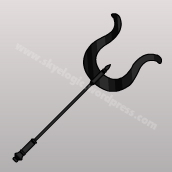
Like the Heqa, the flail was associated with the regal gods such as Andjety and Osiris. In early Egyptian history, it appears on its own (such as in the depictions of the pharaoh Den at his Sed festival on a label from the First Dynasty) but in later times if was often paired with the Heqa staff (or crook). The flail was another popular emblem of pharaonic power. It may also have derived from the ladanisterion which is used to collect ladanum from the leaves of the cistus plant (or other gum bearing plants) which could then be used in the preparation of incense. Its form was clearly ceremonial but probably derived from a shepherd’s whip. The flail (nekhakha) was a short rod with three beaded strands attached to its top. However, they seem to have played different roles in the ceremonies, the Kherep being used by dignitaries and the Aba by commanders. The Kherep Sceptre (“that which directs) and the Aba Scepter (“that which commands”) bear such a striking resemblance to the Sekhem that it can be difficult to distinguish them. Osiris and Anubis were both gods of the underworld who held the epithet “Great sekhem who dwells in the Thinite nome” and the Sekhem was part of the ritual observed in mortuary cults in the presentation of offerings to the ka of the deceased. The Sekhem was closely connected with specific gods – most notably the goddess Sekhmet whose name (“the Powerful One”) was written using the Sekhem. Early dynastic kings were sometimes depicted with the Sekhem in their right hand and a censer or a mace in their left, while high officials usually carried the Sekhem on its own. Deriving from the verb “to be mighty” it was also the logogram for the word “power”. The Sekhem Scepter was carried by gods, kings, and high officials. The Heqa was held by viceroys of Nubia or by the viziers (for example in depictions in the tomb of Tutankhamun). The Heqa was often paired with the flail, indicating that pharaoh was charged with the duty to guide the Egyptian people (represented by the Heqa) and his power to command them (represented by the flail). The earliest representation of a pharaoh bearing the Heqa Staff is a statuette of Nynetjer, but arguably the most famous is that held by Tutankhamun in his sarcophagus. Another early example (this time complete) made from ivory was found in the largest predynastic tomb in the Abydos cemetery (U-j). This Heqa Sceptre was composed of limestone but was in fragments. One of the earliest examples was found in a tomb at Abydos (U-547) dated to the Naqada II period of pre-dynastic Egypt. When Osiris absorbed Andjety, he also adopted the Heqa as one of his emblems. It is thought that the Heqa was originally associated with the god Andjety, who was himself considered to be a ruler. This sceptre became one of the most famous emblems of kingship. It was essentially a long stick with a hooked handle and in later times it was often composed of alternating bands of blue and gold. The Heqa Sceptre (or shepherd’s crook) was closely associated with the king and was even used to write the word “ruler” and “rule” in hieroglyphics. There was also a shorter variant referred to as the Hts (Hetes) staff. The Mekes Staff was also used in the Great Offering ritual, together with the hedj club and the flail. Stone vessels depict Anedjib bearing the mks sceptre, and Djoser is depicted with a similar sceptre on a panel located underneath the Step Pyramid of Djoser. It is thought that it was originally a defensive weapon, used in conjunction with a mace, but soon accrued more ceremonial, priestly connotations. The Mks (Mekes) Staff was a variant of the standard design of long staff, characterised by a nodule approximately half way down the staff. The sceptre also formed the hieroglyph for the fourth nome of Upper Egypt, whose capital was Thebes (known as Waset by the ancient Egyptians). In a funerary context the Was Sceptre was also an amulet which ensured the well-being of the deceased and so often appeared as a decoration on funerary equipment.

The earliest examples date to the First Dynasty.Īn ivory comb from the reign of Djet depicts two Was sceptres supporting the outstretched wings of a falcon (representing the heavens). It symbolised power or dominion and was associated with the gods, as well as with the pharaoh. The Was Sceptre was a long straight staff with two prongs at the bottom and a canine head at the top.


 0 kommentar(er)
0 kommentar(er)
